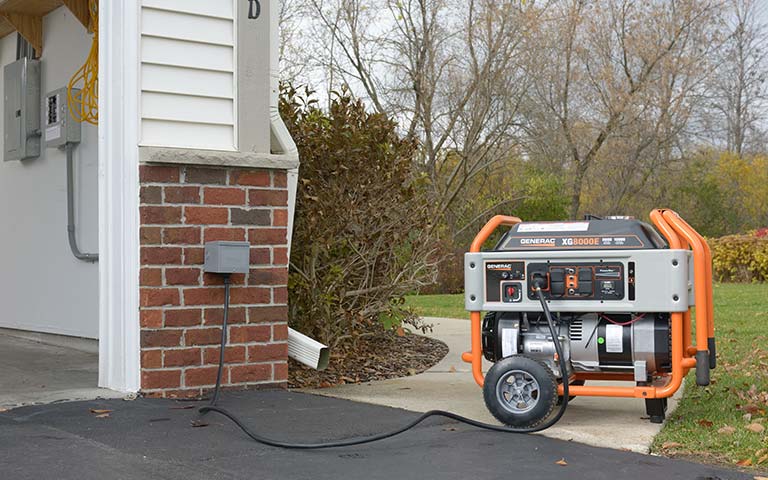Backfeeding a generator involves connecting it to a home’s electrical system without a transfer switch. This practice is dangerous and illegal.
Backfeeding a generator might seem like a quick fix during power outages, but it’s fraught with risks. It can lead to severe electrical shocks or fires. Without a transfer switch, electricity can flow back into the grid, endangering utility workers.
This method also risks damaging the generator and home appliances. Using a transfer switch is the safest way to connect a generator to your home. It ensures that power flows correctly and prevents hazardous situations. Prioritize safety by consulting a professional electrician for proper generator installation. This ensures compliance with local codes and guarantees reliable backup power.

Credit: www.youtube.com
Introduction To Backfeeding
- Backfeeding is a method used during power outages. It involves connecting a generator to a home’s electrical system. This practice is useful but can be dangerous if done incorrectly. Understanding backfeeding is crucial for safety and efficiency.
What Is Backfeeding?
Backfeeding means sending power in the reverse direction. A generator supplies power to the house’s electrical circuits. This bypasses the main utility power source. It’s often done using a double-ended cord, known as a “suicide cord.”
Backfeeding can energize the whole house. It requires careful handling to avoid risks. Incorrect setup can lead to electric shock or damage.
Common Uses Of Backfeeding
Backfeeding is commonly used during emergencies. It keeps essential appliances running. Here are some typical uses:
- Powering refrigerators to keep food from spoiling.
- Running heaters during winter blackouts.
- Operating medical devices that require continuous power.
People also use backfeeding in remote areas. It’s a quick solution where regular power is unavailable. Always follow safety guidelines to prevent accidents.

Credit: www.reddit.com
Risks Of Backfeeding
Backfeeding a generator can be very dangerous. It involves connecting a generator to your home’s wiring without a transfer switch. This practice can cause serious harm and damage.
Electrical Hazards
Backfeeding a generator can create electrical hazards. The power from the generator can travel back into the power lines. This can shock utility workers repairing the lines. It can also cause fires in your home. This happens because the generator’s power is not properly controlled. Always use a transfer switch to prevent these risks.
Damage To Appliances
Backfeeding can also damage your appliances. The power from a generator is not as stable as utility power. This can cause voltage spikes. These spikes can harm sensitive electronics. Appliances like TVs, computers, and microwaves can be damaged. Use a transfer switch to protect your devices.
Below is a table summarizing the risks of backfeeding:
| Risk | Description |
|---|---|
| Electrical Hazards | Can shock utility workers and cause fires. |
| Damage to Appliances | Voltage spikes can harm sensitive electronics. |
Legal And Regulatory Issues
Backfeeding a generator can pose serious legal and regulatory issues. Understanding these issues is crucial. Violating regulations can lead to severe penalties. Each region may have different rules. Knowing these can help you stay compliant and safe.
Local Regulations
Each area has unique local regulations for generator backfeeding. These rules are set by local authorities. They aim to ensure public safety and prevent electrical hazards. You must check with your local building or electrical codes. This ensures your setup follows the law.
| Region | Regulation Body | Key Requirements |
|---|---|---|
| United States | National Electrical Code (NEC) | Transfer switch required |
| Canada | Canadian Electrical Code (CEC) | Permit required for installation |
| European Union | Local municipal codes | Inspection needed post-installation |
Penalties For Non-compliance
Non-compliance with legal and regulatory issues can result in penalties. These penalties can be severe. They may include fines, legal action, and invalid insurance claims. Following the rules is essential to avoid these issues.
- Fines: Monetary penalties can be imposed.
- Legal Action: You could face lawsuits or criminal charges.
- Insurance Issues: Insurance may not cover damages.
Always ensure your generator setup meets local regulations. This helps you avoid penalties and ensures safety.

Credit: blog.norwall.com
Safety Tips For Backfeeding
Backfeeding a generator can be dangerous if not done properly. Ensuring safety is crucial to protect yourself and your equipment. This section will cover the essential safety tips for backfeeding a generator.
Proper Equipment
Using the right equipment is essential for safe backfeeding. You need a transfer switch to connect the generator to your home’s electrical system. A transfer switch prevents electricity from backfeeding into the power grid, protecting utility workers.
- Generator: Ensure it meets your power needs.
- Transfer Switch: Mandatory for safe backfeeding.
- Heavy-duty Extension Cords: Use grounded cords.
- Power Inlet Box: Connects the generator to the transfer switch.
Step-by-step Guide
Follow these steps to backfeed your generator safely:
- Turn off the main breaker in your electrical panel.
- Connect the generator to the transfer switch using a power inlet box.
- Start the generator and let it stabilize.
- Switch on the transfer switch to power your home circuits.
- Monitor the generator’s load to avoid overloading.
- Turn off the generator before refueling or performing maintenance.
- After power is restored, turn off the generator and the transfer switch.
- Turn on the main breaker in your electrical panel.
Remember, safety should always come first when backfeeding a generator. Use the proper equipment and follow the steps carefully to ensure a safe and efficient power supply.
Best Practices For Generator Use
Using a generator safely and effectively is crucial. This ensures your home stays powered during outages. Follow these best practices to maximize efficiency and safety.
Choosing The Right Generator
First, assess your power needs. Calculate the total wattage of all essential devices. Choose a generator that can handle this load. Too small a generator will fail to power everything. Too large a generator wastes fuel.
Consider the type of fuel. Some generators run on gasoline, propane, or diesel. Each has its pros and cons. Gasoline is easy to find but has a short shelf life. Propane has a longer shelf life but can be harder to store. Diesel is efficient but noisy.
Look for features like electric start, fuel gauge, and noise levels. An electric start makes it easier to use. A fuel gauge helps you monitor fuel levels. Noise levels are important for comfort and local regulations.
Maintenance Tips
Regular maintenance keeps your generator in top shape. Follow these tips to extend its life:
- Change the oil: Do this after every 50 hours of use.
- Check the air filter: Clean or replace it regularly.
- Inspect the spark plug: Replace it annually or as needed.
- Run the generator monthly: This prevents fuel from gumming up.
- Store fuel properly: Use fuel stabilizers and keep it in a cool, dry place.
Keep a maintenance log. This helps track when each task was done. It ensures nothing is overlooked.
Alternatives To Backfeeding
Backfeeding a generator can be dangerous and illegal. There are safer alternatives to consider.
Transfer Switches
A transfer switch is a vital device for generator safety. It connects the generator to your home’s electrical system. This ensures a smooth and safe power transfer.
- Prevents electrical backfeed
- Complies with electrical codes
- Easy to install by a professional
Transfer switches come in two types: manual and automatic. Manual switches need you to flip a switch. Automatic switches do this for you. Both types increase safety and usability.
Inverter Generators
Inverter generators are another safe alternative. They are portable and efficient. These generators produce cleaner power for sensitive electronics.
| Feature | Benefit |
|---|---|
| Portability | Easy to move and use |
| Fuel Efficiency | Uses less fuel than traditional generators |
| Quiet Operation | Produces less noise |
Inverter generators adjust their engine speed. This matches the power needed, making them efficient and quiet. They are a good choice for small homes and RVs.
Emergency Preparedness
Being prepared for emergencies is crucial. Power outages can happen anytime. Having a generator can be a lifesaver. Backfeeding a generator can help. But, it’s vital to do it safely. This section will guide you through emergency preparedness.
Creating A Backup Plan
First, create a solid backup plan. List essential appliances. Prioritize what needs power first. Make sure you have enough fuel for your generator. Check the generator’s wattage capacity. Ensure it can handle your essential items.
- Lights
- Refrigerator
- Medical equipment
- Communication devices
Keep a printed copy of your plan. Make sure everyone in your household understands it. Practice the plan regularly. This will make sure you are ready.
Essential Supplies
You need essential supplies for backfeeding a generator. Here is a list of must-have items:
| Item | Purpose |
|---|---|
| Generator | Provide power during outages |
| Fuel | Keep the generator running |
| Extension cords | Connect appliances to the generator |
| Transfer switch | Ensure safe power transfer |
| Manual | Instructions for safe use |
Store these supplies in an easy-to-reach place. Make sure they are in good condition. Check them regularly.
Frequently Asked Questions
What Is Backfeeding A Generator?
Backfeeding a generator involves connecting it directly to your home’s electrical panel.
Is Backfeeding A Generator Dangerous?
Yes, it can be extremely dangerous without proper safety measures.
How Can I Safely Backfeed A Generator?
Use a transfer switch to avoid risks and ensure safety.
Why Is A Transfer Switch Needed?
A transfer switch prevents power from backfeeding into the grid, protecting utility workers.
Can Backfeeding Cause Power Surges?
Yes, improper backfeeding can cause dangerous power surges.
What Are The Legal Implications Of Backfeeding?
Backfeeding without a transfer switch is often illegal and violates electrical codes.
Conclusion
Understanding backfeeding a generator is crucial for safety. Always follow proper guidelines to prevent hazards. Ensure you use transfer switches. Protect your home and family by avoiding shortcuts. Proper installation and maintenance are key. Stay informed and prioritize safety when using generators.
